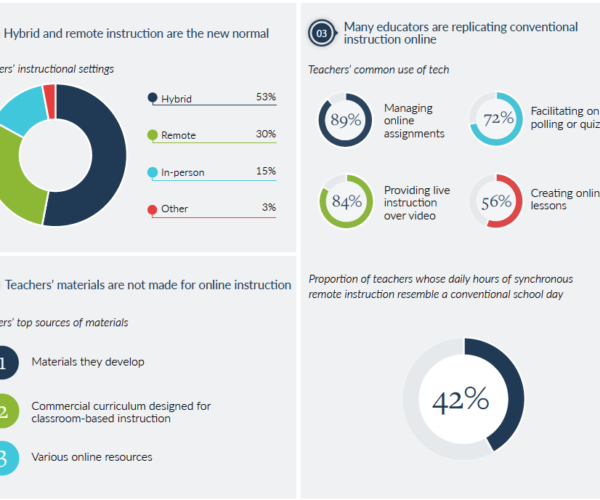The shift to online and hybrid learning, and the ed-tech that comes with it, is giving educators greater opportunities to deliver instruction that is more student-centered, says a new survey.
Innovations are emerging that may redefine education, says the Clayton Christensen Institute’s “Breaking the Mold” survey.
The results provides insights and recommendations for “powering through the pandemic and evolving toward a more student-centered future,” wrote the author Thomas Arnett, a senior research fellow in education at the Clayton Christensen Institute.
However, a significant number of teachers are still using video calls and other technology to replicate traditional classroom-based instruction over video calls, the survey found.
More from DA: 7 steps for engaging remote students
More than 40% of teachers surveyed said the synchronous remote instruction they’ve delivered resembles a conventional school day, the survey found.
The learning management systems, video streaming and other ed-tech now in use are most often designed for migrating traditional classes. to the cloud.
Fewer teachers are using tools that facilitate mastery-based and individualized learning, and other student-centered practices, the survey found.
Teachers also said they are spending more time creating and adapting materials for remote instruction.
These efforts have left less time for connecting with students and families or for learning new techniques for remote instruction and student-centered learning.
Here are the report’s solutions for expanding student-centered learning:
- Help teachers take incremental steps toward student-centered learning: Administrators should offer tools and practices that are easy to learn an incorporate instruction. For example, teachers can record streamed lessons and then post them for students to review at their own pace.
- Identify and support teachers who see conventional practices as “fundamentally broken”: If teachers are given latitude to experiment, they will likely flip classrooms and transition to mastery-based learning. Administrators are likely to retain these teachers as they launch laboratories for innovative practices.
- Reduce the planning and preparation burden: District leaders should prioritize adopting new online curriculum and platforms. States and foundations can help district find high-quality, affordable resources for remote learning.
- Seize this moment to encourage student-centered practices: Administrators should expand teachers’ access to: quality, online curriculum; adaptive learning software and assessment tools; and learning management systems that support mastery-based growth. Teachers also need PD to guide them in adopting these resources.
- Consider setting up a full-time virtual school: In the short run, a virtual school will accommodate families who want more flexible asynchronous learning or who don’t feel comfortable returning in-person. In the long run, these schools can be catalysts for innovation.
“With the right conditions in place,” Arnett wrote, “district virtual schools launched during the COVID-19 pandemic could evolve over time into student-centered models of schooling that eventually replace conventional instruction.”
More from DA: How COVID’s ‘hybrid gap’ hinders less wealthy schools









